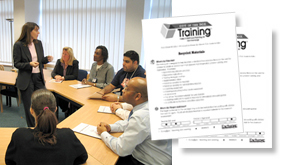ExchangeEveryDay Past Issues
 << Previous Issue
| View Past Issues | | Next Issue >>
<< Previous Issue
| View Past Issues | | Next Issue >> -Nel Noddings, Caring: A Relational Approach to Ethics and Moral Education
"Sometimes a child's difficulties will be expressed in a physical release of tension. There are those children who spit, bite, yell, or want to. Others will hit, slap, pinch, or want to. And yet others will run, stomp, kick, or want to. Claudia Jewett has described these as 'energy zones.' Recognizing a child's energy zone opens the door to creative problem solving by redirecting the energy but continuing to use the child's preferred 'zone'....
"If you allow your mind to wander through the energy zones, a lot of creative, even fun, solutions begin to emerge. Instead of getting into a battle of words with a child whose energy zone is in her mouth, why not say, 'You have a lot of energy in your mouth right now. Try chomping on a carrot (or sipping water through a straw, or singing into the tape recorder . . . ) to get it under control. Then we can calmly find a solution to this problem.' The child who has so much energy in his legs and feet that he cannot rest might respond to a furry strip at the bottom of his cot on which he can rub his bare toes. The child whose hands are getting him into trouble could stop and fold some washcloths. Giving children time and a task to get their emotional energy under control can be more positive and meaningful than time out alone. It also gives the child insight about her energy zone and ideas for gaining control when you are not present....
"Let's use the same creativity and playful spirit to teach children about their emotions and self-control as we do to teach them about their world and how to use tools and materials. Our joys will be greater. With practice, creative solutions will come naturally."
Run a professional development training session with Exchange's popular Out-of-the-Box Training Kits. An article from Exchange magazine serves as the foundation for each Kit and is included as a handout.
 Each Kit includes step-by-step instructions to prepare, conduct, and evaluate your training session. The Kits are also flexible enough to allow you to include your own ideas and exercises to meet any special needs of your staff. The 60+ Out of the Box Kits provide training opportunities in the following areas:
Each Kit includes step-by-step instructions to prepare, conduct, and evaluate your training session. The Kits are also flexible enough to allow you to include your own ideas and exercises to meet any special needs of your staff. The 60+ Out of the Box Kits provide training opportunities in the following areas:
- Health and Safety (7 kits)
- Curriculum Development and Implementation (15 kits)
- Environments (6 kits)
- Family Partnerships (5 kits)
- Professionalism (1 kit)
- Early Care and Education (8 kits
- Infants and Toddlers (3 kits)
- Observation, Assessment, and Documentation (4 kits)
- Positive Discipline (12 kits)
ExchangeEveryDay
Delivered five days a week containing news, success stories, solutions, trend reports, and much more.
What is ExchangeEveryDay?
ExchangeEveryDay is the official electronic newsletter for Exchange Press. It is delivered five days a week containing news stories, success stories, solutions, trend reports, and much more.

We've been saving you time and money for 20 years with resources for parents and teachers. www.parentpagesnews.com Pages, Inc. We're in Spanish too!


Comments (6)
Displaying 5 of 6 Comments [ View all ]Eugene, OR, United States
Buffin's ideas are golden, both for the teachers and parents who apply them and the kids who learn them. My teen – who has struggled tremendously with self control – recently put it this way: "When I get angry, I used to tell myself just to stop. That doesn't really work because it just feels like someone telling me I'm wrong. Now I try to think it through, like, is it really worth it? That feels more like someone trying to help me stay out of trouble." More and more often, he'll drop and do 80 push-ups instead of venting his anger on others.
United States
I enjoyed reading today's article. Redirecting a child's energy to something constructive and creative offers "teachable moments".
Exchange Staff
Redmond, WA, United States
Thank you to Trish for bringing to our attention that the website indicates that the article is out of print. This is a technical glitch that has been fixed. All Out of the Box Kits are in stock and available for order.
Thank you for your patience and understanding!
Headstart
west palm beach, Florida, United States
This will help me working with children with behavioral problem.
Consultant
Youngsville, NC, United States
I have used Jewett's energy zones for many years. Kids seemed relieved to understand what their bodies are doing. One second grader was standing in my office jumping up and down with all her might. I said, "Good for you. You are getting all that angry energy out your feet!" She stopped, looked at her feet and said, "Huh! I never knew that!"
I then said, "Well now that you know, what could you do with all that energy that would be helpful to you?" She responded with, "I could get a soccer ball and practice my kicking." Me, "Bingo! Great plan. Get going."
I could tell story after story about noticing energy zones. This is particularly true of children that are experiencing the divorce of their parents. We our divorce recovery classes I have found making parents aware of the energy zones helps the child and the divorcing parent bring calmness to their newly formed single parent family.
I like the chomp on a carrot. I keep sugarless bubble gum in my pocket. It's easy to pull out when you are out and about. Foods like pretzels are good for angry kids too. I have kids fold thousands of wash clothes down through the years. Washing dishes is another great tool.
Post a Comment